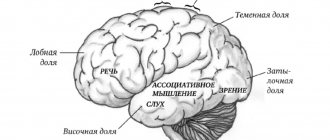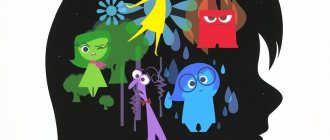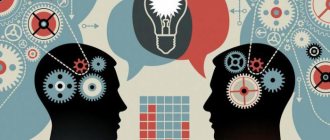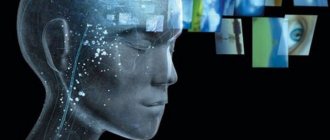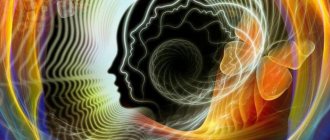Greetings, friends!
Cognition is a complex cognitive process to which we owe all the achievements of human civilization. This amazing natural phenomenon interested the ancient sages even before the advent of philosophy. And today it is the subject of study of epistemology, cognitive psychology and many other sciences. In this article we will focus on the forms of cognition, but to make it easier for you to understand them, let's first briefly look at what cognition is. So,
Content
- Physiological mechanism of perception
- Properties of perception
- Principles of perception
- Perception factors
- Effects of perception
- Classification of types of perception
- Perceptual disturbances Illusions of perception
- Hallucinations Eidetism as a type of hallucination
If we compare the definitions of two mental processes, i.e. perceptions and sensations, then you can notice some features. For example, perception is a more complex process. If sensations reflect individual properties of objects, then perception is a holistic reflection. Thus, the result of perception is a holistic perceptual image of an object, and not a separate property of it.
Methods of cognition
All methods of knowledge can be divided into two large groups (or two levels): empirical (based on direct observation of certain phenomena) and theoretical (based on the analysis of existing information and rational reasoning).
Empirical methods:
- observation - studying an object in its natural environment without any influence on ongoing processes;
- measurement – obtaining numerical characteristics of an observed object by comparing its properties with reference values;
- experiment - the deliberate creation of special conditions and further study of an object placed in these conditions;
- comparison - comparison of the properties of the object being studied with the properties of other objects that have already been studied previously.
Theoretical methods:
- analysis – dividing an object into components and detailed study;
- synthesis - recreating a complete picture from individual parts;
- comparison – comparison of several objects, identification of identical and different properties;
- classification - combining the objects under study into groups based on the presence of identical properties;
- specification - a deeper study of certain properties;
- abstraction - studying a subject from a new angle (with an emphasis on some properties and ignoring others);
- systematization - combining accumulated knowledge into a system in which relationships and patterns are clearly visible;
- induction – inferences directed from the particular to the general;
- deduction - inferences directed from the general to the specific;
- idealization - creating an image of a fictional object with ideal properties and using it as a standard;
- modeling - creating a model of an object for a detailed study of its properties, which is impossible on a real object.
Physiological mechanism of perception
The physiological basis of perception is the processes taking place in the sense organs, nerve fibers and the central nervous system. Under the influence of stimuli at the endings of the nerves present in the sensory organs, nervous excitation arises, which is transmitted along pathways to the nerve centers, and, ultimately, to the cerebral cortex. Here it enters the sensory zones of the cortex, which represent, as it were, the central projection of the nerve endings present in the sense organs. Depending on which organ the sensory zone is connected to, certain sensory information is generated.
Since perception is closely related to sensation, it can be assumed that it, like sensation, is a reflexive process. Ivan Petrovich Pavlov showed that perception is based on conditioned reflexes, i.e. temporary nerve connections formed in the cerebral cortex when receptors are exposed to objects or phenomena.
Temporary nerve connections that ensure the process of perception can be of two types: 1. Formed within the same analyzer; 2. Interanalyzer.
The first type occurs when the body is exposed to a complex stimulus of one modality (for example, a melody). The second type of neural connections formed under the influence of a complex stimulus are connections within different analyzers, the emergence of which Sechenov explained by the existence of associations. These associations in humans are necessarily accompanied by an auditory image of the word, thanks to which the perception acquires a holistic character.
The relationship between sensory and rational knowledge
In philosophy, there are two opposing views on how sensory and rational knowledge relate to each other:
- Empiricism. This approach is based on the assertion that the only source of knowledge is sensory knowledge.
- Rationalism. This approach is based on the assertion that reliable knowledge can only be obtained through rational reasoning in compliance with the laws of logic.
Each of these approaches is an extreme, and in reality both forms of knowledge are closely interrelated. Without sensory knowledge, a person cannot receive information from the outside, and without rational knowledge it is impossible to determine the reliability of the knowledge received. Modern sciences contain a large number of abstract concepts that have no analogues in the material world, and yet, to understand them, it is necessary to have images formed through sensory knowledge.
Properties of perception
1. Objectivity of perception
This is the ability to reflect objects and phenomena of the real world not in the form of a set of unrelated sensations, but in the form of individual objects. Objectivity is not an innate property of perception. The emergence and improvement of this property occurs in the process of ontogenesis, starting from the first year of a child’s life. According to Ivan Mikhailovich Sechenov, objectivity is formed on the basis of movements that ensure the child’s contact with the object (hand movements; eye movements that trace the contour of the object, etc.). Without the participation of movement, images of perception would not have the quality of objectivity.
2. Integrity of perception
Perception gives a holistic image of an object. It is formed on the basis of generalization of information received in the form of various sensations about the individual properties and qualities of an object. The components of sensation are so strongly interconnected that a single complex image of an object arises even when only individual properties or individual parts of the object directly affect a person. This image arises conditionally as a result of the connection between various sensations.
The integrity of perception is expressed in the fact that even with incomplete reflection of individual properties of the perceived object, the received information is mentally completed into a holistic image of a specific object.
3. Structurality of perception
The structure of perception is not just a collection of sensations. It reflects the relationship between various properties and parts, i.e. structure of the subject. Perception brings to our consciousness the structure of an object or phenomenon that we encounter in the real world. We can say that the structure of perception is a reflection of the specific relationship of the elements of the whole. For example, notes enter consciousness, and we recognize the melody, we recognize the triangle in the figure, because we know the aspect ratio of a given figure, or a certain letter remains the same letter despite a different writing style.
Structurality is associated with another property of perception - integrity.
4. Constancy of perception
Constancy is the relative constancy of the image of an object when the conditions of its perception change (for example, a car seems large to us at any distance from it). Constancy is observed to the greatest extent in the visual perception of color, size and shape of objects. Thanks to constancy, which manifests itself in the ability of the perceptual system (a perception system that consists of a set of certain analyzers) to compensate for changes in the conditions of perception, we perceive the objects around us as relatively constant.
A person repeatedly perceives a certain object, and this object is perceived under completely different conditions. This allows the system to maintain relative constancy of the properties of objects and phenomena. Without constancy of perception, people would not be able to navigate the world around them.
5. Apperception
Apperception is the dependence of perception on past experience and personality traits of the perceiver. A person’s knowledge and previous experience play a huge role in apperception. In the process of perception, in order to classify what you perceive, you will put forward and test hypotheses about whether an object belongs to a particular category of objects.
Thus, during perception, past experience is activated. Therefore, one object can be perceived differently by different people. The content of perception is determined by the task, motives of activity, interests. An essential place in apperception is occupied by attitudes and emotions, which can easily change the content of perception.
6. Meaningfulness of perception
Meaningfulness of perception is the property of human perception to endow the perceived object with a certain meaning. Perception is not determined simply by a set of stimuli, but is a constant search for the best interpretation of the data received.
We perceive objects that have a certain meaning. Regardless of the constantly changing content, we learn the same subject. Human perception, being a kind of awareness of objects and phenomena, includes the act of understanding and comprehension.
7. Activity (selectivity) of perception
Selectivity of perception lies in the fact that at any given time we perceive only one object or a specific group of objects, while other objects in the surrounding world are the background of our perception (not reflected in consciousness).
For example, while in a lecture hall, you listen to a lecture without noticing that someone behind you is discussing plans for the evening. Your perception is directed towards the lecture until you are asked about your plans. In this case, you will already be communicating and not listening to a lecture, i.e. perception will be directed towards the interlocutors.
What is cognition?
Cognition is a set of processes and methods of obtaining knowledge about the world around us. This is a broad concept that covers both the natural desire to find a rational explanation for the processes occurring around us, and artificially created methods for obtaining and accumulating knowledge. People tend to strive to explain every phenomenon of the world around them, and it is this desire that is considered the main factor in the emergence and development of human civilization.
Cognition has a complex structure, with five main structural elements fundamental to it:
- Subject. This is the one who gains knowledge by putting some effort into it. Any person reading a book or article on the Internet, conducting experimental observations or performing theoretical calculations is at this moment a subject of knowledge.
- An object. This is what cognitive activity is aimed at. For example, for readers of this article, the object of knowledge is knowledge itself as a concept and phenomenon.
- Motive. This is a factor that causes a craving for knowledge, for example, interest. The motive can be practical (the desire to obtain a higher education and secure career prospects) or theoretical (deriving pleasure directly from the process of learning). A person is guided by theoretical motives, for example, when reading an article about string theory or the structure of the universe. This process brings pleasure from learning, although it does not provide knowledge of practical value.
- Target. Purpose and motive should not be confused. The goal of cognition is to obtain complete, accurate and reliable knowledge about the object being cognized.
- Result. The result of knowledge is knowledge itself. It is worth noting that the result is sometimes achieved even without intentional cognitive activity. For example, a child gains knowledge the first time he falls and breaks his knee, the first time he gets burned, hurts his finger, or gets a splinter. He definitely does not seek such experience, but he gains knowledge.
Principles of perception
A group of psychologists, together with Max Wertheimer, a German psychologist and founder of Gestalt psychology, formulated the laws of perception, which became the theoretical basis of Gestalt psychology.
1. The principle of proximity Elements that are close to each other in space and time and that seem to us to be united in groups, we perceive together.
2. Principle of Continuity There is a tendency to follow a direction that allows observed elements to be linked into a continuous sequence or a specific orientation. In the figure we see not just individual dots, but two intersecting lines.
3. Principle of similarity Similar elements are perceived by us together, forming closed groups. Because of the color, we perceive the points in the figure as rows rather than columns.
4. Closure principle There is a tendency to complete unfinished items and fill empty spaces.
5. The principle of simplicity (the law of content, the principle of good form, the law of pregnancy) We perceive and interpret composite or complex objects as the simplest form or a combination of the simplest forms. In the figure we see three different simple figures, and not one complex one.
Pregnant gestalt means that in any conditions we strive to see the figures as complete as possible.
6. Figure-ground
We strive to organize our perception in such a way as to see the object (figure) and the background against which it appears. The object is brighter, more significant, and noticeable.
Basic approaches to the study of perception
In psychology, there are two main approaches to the study of perception: object-oriented and subject-oriented. Let's look at several theories in each of them.
Object-oriented approach
Let's consider two theories within this approach:
- Structuralism. W. Wundt and E. Titchener believed that perception is a combination of individual images and sensations. To explain some human condition, you need to break this condition down into parts. Perception is based on two laws: summation (the total effect of sensations is equal to the effect of each sensation) and association (contrast, affectivity, similarity in content, similarity in time and space).
- Gestalt psychology . M. Weitheimer, K. Koffka, V. Köhler believed that images can only be perceived holistically - it is unacceptable to consider the constituent elements separately or in the sum of their properties. For example, if you remove one letter from a word, most people will not notice it. And if they notice, they will still understand what the word is. That is, if a person has already perceived something once, then under similar conditions he will perceive a similar figure in exactly the same way. In this case, the figure is always perceived more clearly than the background.
Subject-centered approach
Let's consider two theories within this approach:
- The theory of unconscious inferences by G. Helmholtz . The psychologist believed that a person does not just passively “absorb” the world, but tunes his senses for better perception. Perception itself is the result of what comes from the outside world and what is already inherent in a person. Helmholtz was the first to talk about the fact that one receptor is responsible for only one sensation. A person can experience several sensations at once only if something from the external environment has affected several receptors at once. Thus, the psychologist promoted the idea of sensory perception.
- The theory of the perceptual cycle by U. Naiserra . The psychologist was the first to talk about cognitive schema (accumulated experience in structures and stereotypes). He believed that there is already something inside a person that determines the specificity of perception. For example, if a person has often encountered irony and ridicule, then he will perceive any compliment as irony.
These are just some of the theories of perception in psychology. In fact, there are many more of them. For example, there are also such theories: categorization (D. Bruner), constructivist (J. Piazget), activity (A.N. Leontiev), ecological (D. Gibson), information (D. Marr).
Perception factors
Our perception depends on external and internal factors.
a) External factors: - intensity of the stimulus; — size of the stimulus; — stimulus contrast; - movement of the stimulus; - recognition of the stimulus.
b) Internal factors: - human attitude; — needs; - experience; — personal characteristics (self-esteem, left- or right-handedness, optimism-pessimism, etc.); - effects of perception.
Effects of perception
Let us highlight the main effects (errors) of perception:
The projection effect is the ability of people to attribute their own advantages to a pleasant person, and their shortcomings to an unpleasant person. Those. the effect suggests that other people have the same qualities as the perceiver.
The halo effect is the formation of a specific attitude towards a person through the directed attribution of certain qualities to him; information received about a person is superimposed on the image that was created in advance. Those. the effect is to extend the general opinion to the particulars.
The primacy and recency effect is the tendency of people, when faced with conflicting information about another person, to give more weight to information received first (if a stranger is perceived) or more recent information (if an old acquaintance is perceived).
The effect of physiognomic reduction is the ability of people to draw conclusions about the character and psychological characteristics of a person based on the features of his appearance.
Classification of types of perception
1) Separation by modality: - visual perception; - auditory perception; - tactile perception; - taste perception; - olfactory perception. Combinations of different types of perception are possible.
2) Division by object of perception: - perception of space (includes the perception of size, shape, relative position of objects, their relief, distance and direction); — perception of time (reflection of the duration and sequence of phenomena or events); — perception of movement (reflection of the direction and speed of the spatial existence of objects); — perception of speed; - perception of direction; - perception of a work of art; - perception of the main phenomena of human life.
3) Separation by goal: - intentional (voluntary) perception (we are guided by a previously set goal or task); - unintentional (involuntary) perception (lack of volitional activity and purpose).
4) Division according to the participation of other psychological formations: - emotional perception (perception associated with emotions and feelings); — rational perception (perception subordinate to the thinking process).
Perception disorders
1) Illusions are erroneous perceptions of real objects and phenomena. They can be auditory, visual, olfactory, etc.
Under certain conditions, they occur in most people and can be caused by physical (perception of a spoon in a glass of tea that appears broken), physiological (split images of objects if you press on the side of the eyeball at the moment of perception) and psychological reasons (overestimation of vertical lines compared to horizontal ones) .
Illusions of perception
a) Ebbinghaus illusion
This is an optical illusion of perception regarding size. Two objects of the same size can look different. If one object is placed among smaller objects, it will appear larger than if the same object is placed among larger objects.
b) Ponzo illusion
This is an optical illusion of perception. Mario Ponzo suggested that the human brain determines the size of an object by its background. He drew two identical segments against the background of two converging lines, like a railway track stretching into the distance. As a result, horizontal lines are perceived differently.
c) Aristotle's illusion
This is an illusion of touch. A small object (pencil) is placed between (under) crossed fingers (it’s easier to use the middle and index fingers) so that it touches one finger on the inside and the other finger on the outside. When you move your fingers (and hand) over an object (back and forth), after a while you get the impression that your fingers are touching 2 objects.
d) Zellner illusion
An optical illusion in which parallel lines intersected by a series of short diagonal lines appear to diverge.
e) Müller-Lyer illusion
An optical illusion that occurs when observing segments framed by arrows. The segment framed by the “points” seems shorter than the segment framed by the “tail” arrows.
f) Poggendorff illusion
An optical illusion where the red line is a continuation of the black line, rather than the blue one.
Hallucinations
2) Hallucinations are erroneous perceptions in the absence of an object.
Hallucinations occur with alcohol abuse (delirium delirium), drugs, psychostimulants (LSD, cocaine, etc.), medications (for example, antidepressants), mental illness (schizophrenia, epilepsy), organic brain lesions, cataracts (Charles hallucinations). Bonnet).
